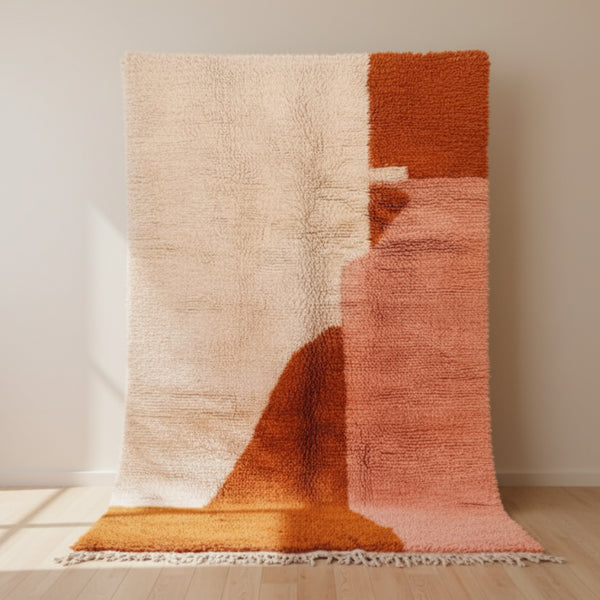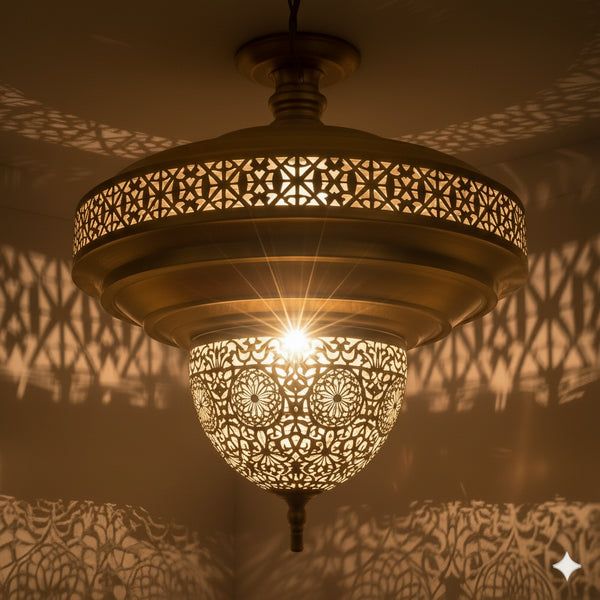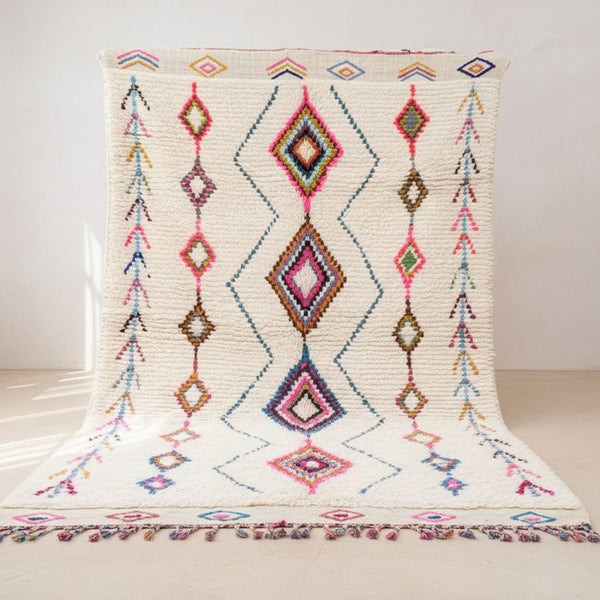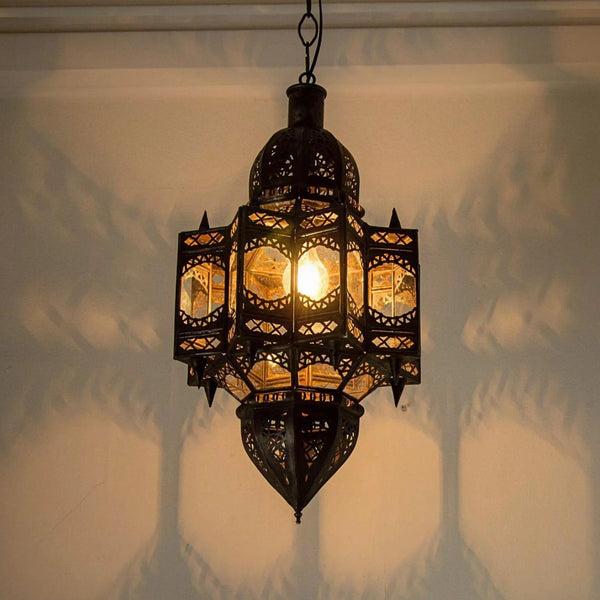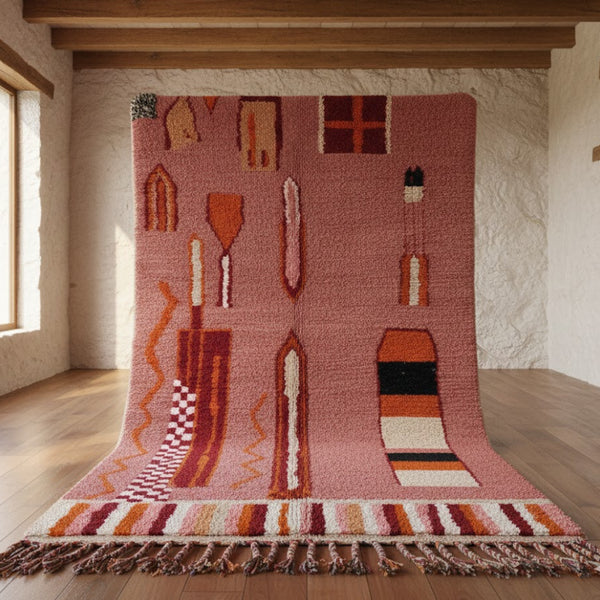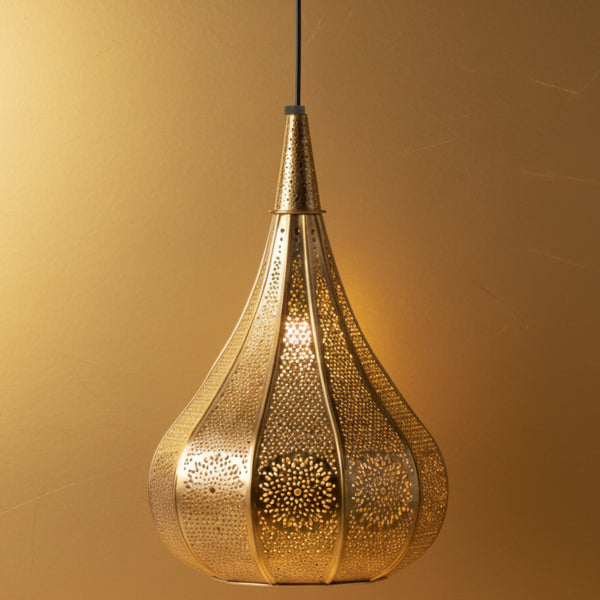Layering Bohemian Rugs & Lighting: A Visual Style Guide
Posted by AADIL KHAN
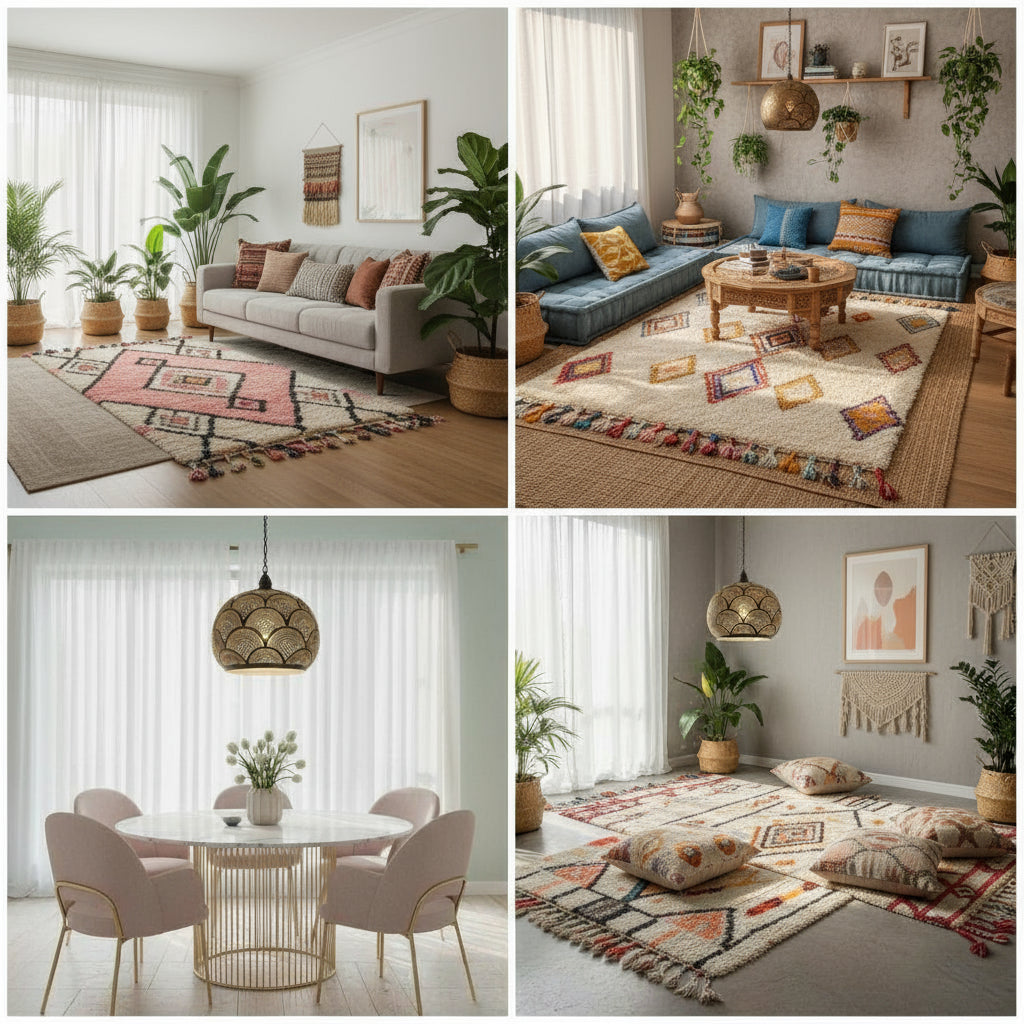
A guide to how to layer bohemian rugs and lighting to get a certain look
To make truly beautiful bohemian interiors, you need to learn how to layer, which is the skill of using different rugs and lighting sources in smart ways to add depth, warmth, and visual interest. Unlike single-statement pieces that stand alone, layered elements create conversation and context. Each piece adds to the others, telling a story of collected beauty and planned comfort. The magic happens when different pieces work together. For example, when a vintage kilim floats on top of a soft wool foundation, when brass ceiling fixtures cast intricate patterns on layered textiles below, and when multiple light sources at different heights turn flat rooms into three-dimensional sanctuaries. This visual style guide takes the vague idea of layering and turns it into real, usable techniques that will make your space go from being just decorated to being carefully curated. These tried-and-true tips show you how professional designers create the effortlessly layered look that defines exceptional boho interiors, whether you're starting from scratch or improving an existing bohemian scheme.
The Basics and Philosophy of Layering Art
To understand layering as a design principle, you need to see it as more than just adding more items. It's about creating visual depth through careful placement, scale progression, and thematic harmony that rewards looking closely. The key to successful layering is to create a clear hierarchy, where some elements act as anchors and others act as accents. This keeps things from looking chaotic, which happens when every part needs equal attention. This hierarchy makes natural focal points that lead the eye through spaces in a planned way, rather than bombarding viewers with too much information at once.
Layering creates a "collected over time" look that can't be copied by going shopping once or buying matching sets. Each layer should feel like a new discovery that fits in with the other layers, making a personal story through objects instead of just organizing them. This philosophy frees you from the need for everything to match, but it also requires you to be more careful to make sure that all the different pieces come together in the end, even though they come from different places and were bought at different times.
To balance pattern and texture across layers, you need to know when to add complexity and when to give the eyes a break. If your base rug has a lot of patterns, you might want to use simpler overlay textiles. If your base rug is neutral, you can use bolder accent layers. Ornate light fixtures look great over rugs with subtle textures, while simple light fixtures let bold textile patterns stand out. Instead of making everything in your layering scheme the same, you want to make dynamic tension.
Building from the foundation to the accent follows a natural order from the biggest and most neutral to the smallest and most unique. Your base layer, whether it's fabric or lighting, sets the mood and gives the space stability. The layers that come after it add personality, color, and visual interest, which makes spaces interesting. This progression makes sure that your space feels grounded instead of chaotic, even when you add a lot of bold elements during the layering process.
Choosing Your Base Handmade Moroccan Wool Rug: The First Step

Choosing the anchor handmade Moroccan wool rug that ties your whole textile layering scheme together is probably the most important step in the process because it affects every other choice you make. Considerations of size become very important. Your base rug should be big enough to cover the area around your furniture, making it feel like a separate zone rather than a cramped space. All of the front legs of the furniture in the living room should rest comfortably on the rug, leaving enough space around the edges. For standard furniture groupings, the rug should be at least 9x12 feet or larger.
Whether you choose a neutral or patterned base depends on how you see things and how comfortable you are with mixing patterns. Cream, beige, or soft gray neutral foundations are the most flexible for layering bolder accent rugs on top. They also give busy bohemian schemes a strong, calming presence that keeps everything together. Beni Ourain rugs with simple geometric patterns on ivory backgrounds are great examples of neutral bases that add a little visual interest without getting in the way of other textiles. On the other hand, patterned bases look great when you want to keep your foundation rug simple or when you want it to make a stronger statement that can still be seen around the edges.
When choosing handmade Moroccan wool rugs for your foundation, the height of the pile is very important. A higher pile gives the rug a thick, plush feel that is essential for bohemian comfort and adds literal depth that makes overlay rugs look like they were intentionally layered instead of just thrown together. The thick pile of real Moroccan wool rugs also keeps overlay textiles from sliding or bunching, which keeps the clean lines that set professional layering apart from random placement.
To get the most out of your foundation rug, place it in the center of your main furniture group so that the edges are the same length on all sides. This balanced arrangement gives the seating area a sense of purpose and makes it feel like one unit. Foundation rugs in bedrooms should go beyond the bed frame on three sides: the two long sides and the foot. This gives the bed soft landing spots and makes it look bigger and more important in the room.
Adding Visual Interest with Layers of Bohemian Rugs

The key to making a professionally styled room look different from a room with just one rug is to layer secondary bohemian rugs over your foundation piece. This gives the room depth and a collected look. The traditional way to do this is to put kilims over pile rugs. The flatweave fabrics sit on top of soft wool foundations, like colorful islands of pattern in a sea of neutral colors. This combination creates both visual and tactile contrast. The geometric precision of kilim flatweaves and the organic texture of hand-knotted pile create dynamic tension that stimulates multiple senses at once.
To mix patterns and colors well, you need to know how to use scale relationships to keep things from competing with each other visually. If your base has big, bold geometric patterns, your overlay bohemian rugs should have smaller, more detailed patterns. This will make the two look good together. You can use either harmonious or contrasting color schemes to coordinate colors. For example, pulling accent colors from your foundation rug creates a cohesive flow, while adding completely new colors gives the scheme an unexpected boost of energy that keeps it from feeling too coordinated or matchy.
When you stack rugs on top of each other, the sizes usually go from biggest to smallest, with each layer showing a lot of the layers below it. A common way to do this is to put a medium-sized rug (5x7 or 6x9) on top of a large base rug (9x12) so that 12 to 18 inches of the base rug is visible around the edge of the overlay. This visible border makes the framing look intentional instead of like the overlay just couldn't cover the whole base. This sets thoughtful layering apart from practical necessity.
There are two ways to place overlay bohemian rugs: centered and offset. Each method gives the rug a different look. Centered placement gives a formal look that works well in traditional spaces or under coffee tables, where balanced borders make the geometric arrangement look better. Putting the overlay rug off-center creates asymmetry and a relaxed, spontaneous look that is perfect for bohemian style. It can be placed to one side or at an angle that suggests natural growth instead of careful planning.
Brass ceiling lights add drama to the overhead space.

By choosing the right brass ceiling lights, you can create the ambient lighting layer that all other lighting builds on. This also adds sculptural interest to the ceiling, which is often overlooked. These ceiling lights serve two purposes: they provide light and they add decoration that draws the eye up, making the space feel more vertical and less flat or ground-focused, even though there is a lot of textile layering below.
Brass ceiling lights that are flush mount or semi-flush work great in rooms with standard 8-foot ceilings where hanging lights might feel too heavy or cause head-bumping problems. These styles put decorative metalwork close to the ceiling while still showing off the warm brass tones and perforated beauty that go well with the layered fabrics below. The patterns these lights make on ceilings add more visual interest to the space above, turning blank spaces into shadow-play canvases that change as the day goes on and the natural light moves.
In rooms with higher ceilings, statement chandeliers and bigger brass ceiling lights can be used because their size gives them the right amount of visual weight without making the room feel too crowded or causing problems. These dramatic pieces are like jewelry for the room. They instantly give it a bohemian feel and provide a lot of ambient light. When placed above layered rug arrangements, large ceiling fixtures create vertical alignment that brings together floor and ceiling treatments into a single unit instead of separate horizontal layers.
Brass ceiling lights give off a warm metallic glow that goes well with the rich colors of layered rugs. The color temperature harmony makes the rooms feel like they are all connected from floor to ceiling. Brass has a golden color that goes well with the natural wool colors in handmade rugs. It also looks good against cooler-toned fabrics like indigo kilims or gray foundations. This color relationship makes things feel connected on a subconscious level, even if they come from different places and times.
Adding character with Artisan Ceiling Lights
Putting artisan ceiling lights at the top of your bohemian layering scheme shows that you value the handmade look that is at the heart of real boho style. It also makes sure that your lighting has the same soulful quality as the handwoven textiles below. To tell if something is of artisan quality, you need to look for small differences that show it was made by a person, like small differences in the patterns of holes, the way the metalwork ages naturally instead of artificially, and the fact that solid metalwork is much heavier than hollow stamped metalwork.
The way handmade lighting goes with handwoven textiles goes beyond just looking good together. It also has a philosophical connection: both are traditional crafts that are threatened by mass production. Putting them together is a celebration of the continuity of artisanship across different mediums. When your textiles show the marks of different weavers and your lighting shows the marks of different metalworkers, you create layers of authenticity that go beyond just how they look together. This shared story of how things were made by hand gives them more meaning, turning them into cultural artifacts.
To add authenticity to artisan ceiling lights, you need to buy them from trustworthy dealers who work directly with craftspeople or cooperatives to make sure they get paid fairly and use traditional methods. Many real items come with certificates that show who made them and where they came from. This adds provenance, which makes them worth more money and more sentimental value. Even without formal documentation, you can tell that an artisan's work is high quality by the way they build things, the materials they use, and the finishing techniques they use that can't be copied by factories.
Choosing lighting that fits with the bohemian craft ethos shows that you value traditional skills, don't like the disposable consumer culture, and want to support living craft traditions. Not only do artisan ceiling lights look nice, but they also help communities that have been making metalwork for centuries. This makes your design choices more meaningful than just how they look.
Lighting Layers in Buildings: From General to Specific
The three-tiered lighting approach changes spaces from being evenly lit to being dynamically layered, with each type of lighting serving a different purpose while adding to the overall lighting. Ceiling fixtures provide ambient lighting that makes spaces easy to move around in and comfortable. This is the base level of light that other layers build on. Your brass ceiling lights do this basic job by filling rooms with warm, even light that makes everything visible without creating harsh shadows or dark spots.
Floor and table lamps provide task lighting for specific activities like reading, working, and cooking, with focused light where ceiling fixtures alone don't work. These portable lights give you more options than ceiling lights that are permanently installed. You can change the lighting as your furniture arrangements or activities change. Different heights of floor lamps create vertical layers that go well with your horizontal textile layers. This makes the eyes move through the whole height of the rooms instead of just at floor level.
Accent lighting uses decorative fixtures, string lights, or spotlight-style pieces to highlight certain features or create mood effects. These lights add sparkle and visual interest without being the main source of light. These last layers of light give the room character and a finishing touch, just like small accent rugs or throws do for textile layering schemes. To make bohemian spaces feel alive and welcoming, you can use Moroccan lanterns on consoles, strings of warm-bulb lights draped casually, or small brass table lamps on shelves.
The goal is to have full lighting at different levels that can be changed by turning on and off certain lights and dimming others. How each layer works together determines how well the lighting works overall. A bohemian room with good layers shouldn't need all the lights on at once. Instead, different combinations of lights can meet different needs and moods. For nighttime entertainment, you might only need ambient ceiling lights and accent lighting. For daytime reading, you might need task lamps. This flexibility makes spaces truly livable instead of just looking good in pictures.
Visual Balance: Making Sure That Rugs and Lights Work Well Together
To get layered fabrics and lighting fixtures to look good together, you need to know how geometric vocabulary makes visual connections that bring together different parts into a single scheme. When you match geometric textiles with geometric metalwork, it's easy to see how they go together. For example, diamond patterns in kilim rugs look like diamond-shaped holes in brass fixtures, which creates a pattern that subconsciously ties together the floor and ceiling treatments. This method works especially well for people who want clear coordination that feels planned and thought out.
By mixing busy rugs with simpler fixtures, you can avoid sensory overload by making sure that some parts of the pattern-rich schemes give your eyes a break. If your layered bohemian rugs are very complicated, with lots of patterns at different scales, rich colors, and intricate details, choose lighting fixtures with cleaner lines and less perforation work. Let textiles add variety to patterns while fixtures add interest to the shape of the space instead of just the surface.
Using color echoes makes textiles and lighting work together in a way that isn't too obvious. Take one accent color from your layered rug scheme and use it again in glass pieces in brass fixtures. Or, make sure that the metallic tones in the fixtures match the warm colors in the textile dyes. These color bridges make the pieces feel like they belong together, as if they were chosen to go together instead of being bought as a set.
Repeating things to make a visual rhythm sets up patterns of recurrence that lead the eyes through spaces in pleasing ways. Use the shapes or holes in several light fixtures to repeat certain geometric shapes that are already in your rugs. Use curved lines that are similar in both the patterns on the fabric and the shapes of the fixtures. These repetitions make visual music—patterns that come and go in your layered scheme in ways that keep things interesting while also bringing the theme together.
Texture Play: Putting Soft Fabrics and Metal Fixtures Together
The difference in texture between smooth brass and woven wool makes touch interesting, even from across the room, adding depth beyond just how it looks. This mix of hard and soft, refined and organic, processed and natural materials gives bohemian spaces their rich and collected feel. Polished metal's cool, smooth surface is a good contrast to the warm, soft texture of natural fibers. This keeps designs from feeling too soft or too harsh.
Adding metals other than brass to your material story makes it more interesting while keeping the metallic base that goes with brass ceiling fixtures. Copper accents on lamp bases, aged iron in candle holders, or mixed metal side tables make layered metallics that look like they've been collected rather than matched. These different metal finishes should all have warm undertones that keep the temperature consistent, even when mixing cool chrome with warm brass.
Adding wood elements fills the space between metal fixtures and textile layers with organic material that has the same natural origin as textiles but is much more durable than metals. Wooden ceiling beams, lamp bases, or mirrors with wooden frames can help metal and fabric feel like they go together instead of competing with each other. Wood's natural grain and warm tones go well with both brass fixtures and wool rugs, making a three-way harmony of materials.
To make full material stories, you need to spread textures throughout spaces instead of putting all the soft surfaces in one place and all the smooth surfaces in another. To make the ceiling fixtures talk to each other, put brass bowls, copper planters, and metal-framed art in different rooms. Spread out textile layers like woven wall hangings, throw pillows, and upholstered furniture to make sure that the soft texture shows up at different levels. This distribution makes the material richer and encourages exploration instead of showing everything at once.
Room Demonstrations: Showing How to Use Layering Techniques
Living Room Layering Sequence: Start with a large 9x12 Beni Ourain handmade wool rug in cream with small brown diamonds. Place it so that all of your furniture's front legs rest on it and it fits all of your seating. Put a 6x9 vintage Turkish kilim in faded terracotta, indigo, and saffron in the middle of the coffee table so that 18 inches of the cream base show around all the edges. For more texture, put a small Moroccan leather pouf or sheepskin next to the reading chair. Put a big brass ceiling light in the middle of the room to light it up, then add two floor lamps with brass bases in opposite corners for task lighting. Finally, put a brass table lamp on the console to add some extra light. This progression makes a full layer from floor to ceiling, with each part making the others better.
Begin with an 8x10 handmade Moroccan wool rug in natural undyed gray that goes under your bed and 24 inches past the footboard. This will make soft landing zones on three sides. Put a colorful 4x6 runner with bold geometric patterns at the foot of the bed. It will add personality without taking away from the calm base. Put small 3x5 accent rugs next to each nightstand to make walking around barefoot more comfortable. Install an artisan brass ceiling fixture to give the bedroom some ambient light. Add matching Moroccan pendant lights on either side of the bed at the right height for reading. Finally, put a decorative brass accent lamp on the dresser. This layering gives the bohemian bedroom a cozy, collected feel while still providing the light needed to get dressed and read at night.
Layering Mistakes That Happen All the Time and How to Avoid Them
When too many textile layers fight for attention or make it easy to trip over too many edges and bulk, they make things look messy and dangerous. Don't give in to the urge to add every pretty rug you see. Most spaces can only handle three layers of textiles, and two layers are more common and often more successful. In the same way, average rooms should have between four and eight lighting layers. This gives you options without overloading circuits or making maintenance a nightmare.
Under-layering makes spaces feel incomplete and unfinished, even when the individual pieces are high quality. This doesn't create the dimensional richness that makes bohemian styling so appealing. A single rug, no matter how beautiful, and one ceiling light can't create the layered depth that makes the style. To get a basic bohemian look, you need at least one foundation textile, one accent textile, and three lighting sources at different heights.
When rugs or fixtures don't fit the room or each other properly, even beautiful combinations can look bad. Overlay rugs should be much smaller than the foundation layers. For example, an 8x10 overlay on a 9x12 base looks strange and unintentional. Small accent rugs get lost on big bases, and big overlays cover up too much of the base layer. The lights should be in proportion to the spaces they light up and the layers of fabric below them.
When you layer rugs without thinking about how traffic flows, you end up with problems that make you have to move them around even though they look good. Make sure that the textile layers don't make it easy to trip over in circulation paths, that the edges of the rugs don't curl up from being walked on too often, and that the lights don't get in the way of views or make people bump their heads. For layering to be sustainable, it must stay livable.
In conclusion, your layered bohemian vision
When you learn how to layer bohemian rugs and lighting, you can turn a house into a home that is warm, full of character, and full of the beauty that makes spaces truly unique. Start with the basics and add to them over time. This will let your layered vision grow naturally as you find things that fit with your growing sense of style. Trust the process, accept that real bohemian style is imperfect, and keep in mind that the best layered schemes take time to develop instead of appearing fully formed. Your layered bohemian sanctuary is waiting for you, one thoughtful touch at a time.
